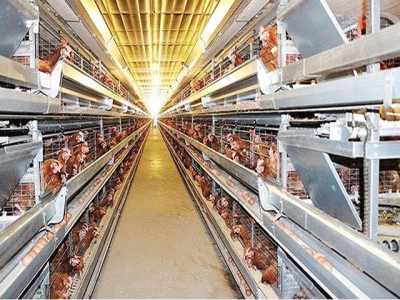Export of poultry products sees great potentials

For decades, output of animal husbandry of Vietnam has mainly served domestic market. However, currently, the Ministry of Agriculture and Rural Development has opened policies to encourage firms to promote export of, first of all, poultry products to potential markets thanks to plentiful supply.
Poultry farming industry of Vietnam has great potential and advantage for export. (Photo: SGGP)
According to Mr. Nguyen Xuan Duong, head of the Department of Livestock Production, poultry farming has recently seen an improvement from small-scale farming to intensive farming. Productivity and profits are both increasing, thus, poultry farming is no longer a secondary occupation but a main direction in agricultural production in some places.
During the past years, the number of poultry increased an average of above 6 percent annually. By 2018, production of poultry meat exceeded 1.1 million tons and production of poultry eggs topped 11 billion eggs. Currently, farmers across the country have been raising around 409 million domestic fowls, of which chickens accounted for 77.5 percent and the rest 22.5 percent was waterfowls. Production of eggs also surged drastically with a growth of 11.4 percent. At the present, domestic fowls have been raising widely across the nation.
In the Southeast region, Binh Duong Province has the highest growth rate of 10.5 percent of poultry flock while Dong Nai has the largest poultry flock with nearly 20.5 million fowls. In the Red River Delta, Ninh Binh and Quang Ninh provinces have the highest growth and production. Ha Noi has the largest poultry flock with more than 25.6 million fowls.
Currently, there are two main models of farming, consisting of intensive farming and household-farming. Of which, intensive farming tends to develop rapidly with 10,000-12,000 farms, mainly in the Red River Delta, the Southeast region and the Mekong Delta.
As for market, Mr. Nguyen Xuan Duong said that animal husbandry in general and poultry farming in particular has served domestic consumption fairly well, contributing to price stabilization and bringing high income for farmers. However, amid increasing supply, the industry should consider export to increase economic value that animal husbandry is able to provide.
In the past three years, some firms have exported poultry products to other countries. Export value of poultry products has increasingly posted growth. Poultry exports exceeded US$3.05 million in 2016, climbed to $5.58 million in 2017 and reached more than $18 million in 2018.
Currently, poultry products of Vietnam include fresh duck eggs, boiled salted duck eggs, salted duck yolks, processed chicken meat, canned quail eggs, egg powder and braised black-bone silky chickens. Every year, the country exports from 1.25 million to 1.5 million fowl breeders and around 10-15 million salted duck eggs. Export of chicken meat started from September 2017 and nearly touched 8,000 tons of processed chicken meat in 2018.
According to Mr. Nguyen Thanh Son, chairman of the Vietnam Poultry Association, the local poultry farming industry has a big opportunity when Vietnam has joined several free trade agreements which are expected to help firms to approach more new markets with great potential.
Amid concern that Vietnamese poultry products will not be able to compete in export markets, Mr. Nguyen Quoc Toan, acting director of the Agro Processing and Market Development Agency under the Ministry of Agriculture and Rural Development, said that firms should identify each target market and consumer taste of import country so as to divide market segment for export poultry products suitably.
For instance, firms should boost export of chicken breast because this product is in high demand and favored by import markets while chicken thighs and wings are for domestic market. According to Mr. Toan, target markets of Vietnamese firms in exporting chicken meat include Japan, China and the Philippines and potential markets are Arab Saudi and South Africa. As for poultry eggs, firms should concentrate export to traditional markets in Northeast and Southeast Asia.
Despite plentiful supply and high import demand, Mr. Pham Van Dong, head of the Department of Animal Health, said that exporting poultry meat products is not easy because of technical barriers and strict control on food safety and hygiene from import countries.
He cited that it took the Ministry two years to negotiate with Japanese authority in order for Vietnamese chicken meat to be exported into Japan. At the present, although having received approval from Japanese authority, each batch of poultry products imported from Vietnam has to be kept for Japanese veterinary agency to check for pathogen and antibiotic residues. Therefore, if firms want to promote export, they will have to invest in closed-loop farming system or apply modern processing technology. In addition, they should strictly control diseases and should not use antibiotics and banned substances in farming. If there is an outbreak of diseases, export of poultry products might be possibly halted and firms will lose market.
Có thể bạn quan tâm
 Vietnam's rice export prices cheaper than Thailand’s
Vietnam's rice export prices cheaper than Thailand’s According to the Ministry of Agriculture and Rural Development, export of rice was estimated at 1.43 million tons, worth US$593 million
 The flower trade is blooming tough
The flower trade is blooming tough Despite being renowned for high quality flowers, Lâm Đồng Province still faces problems such as poor storage and lack of new, high quality seeds that hinder it
 Agricultural production: businesses make big investments in processing
Agricultural production: businesses make big investments in processing Vietnam needs to make basic changes in agricultural production and may have to start over from scratch, according toTran Ba Duong